Electronic Patient Blood Management: A Core Measures Comparison Report
VerifiedAdded on 2022/09/17
|10
|1264
|16
Report
AI Summary
This report provides an in-depth analysis of Electronic Patient Blood Management (ePMB) as a core measure, focusing on its implementation by The Joint Commission (TJC) to ensure adherence to federal regulatory standards within healthcare facilities. The report explores the benefits of ePMB for consumers, the government, and healthcare organizations. The discussion highlights the significance of ePMB in optimizing patient care, particularly for patients requiring blood transfusions, by emphasizing the three primary stages of ePMB: preoperative anemia screening, preoperative blood type testing and antibody screening, and initial transfusion threshold. The report underscores the importance of electronic blood management in enhancing patient safety, reducing mortality and morbidity rates, and improving the overall quality of healthcare. It also emphasizes the need for government support and public awareness to maximize the positive impact of ePMB on the healthcare system.
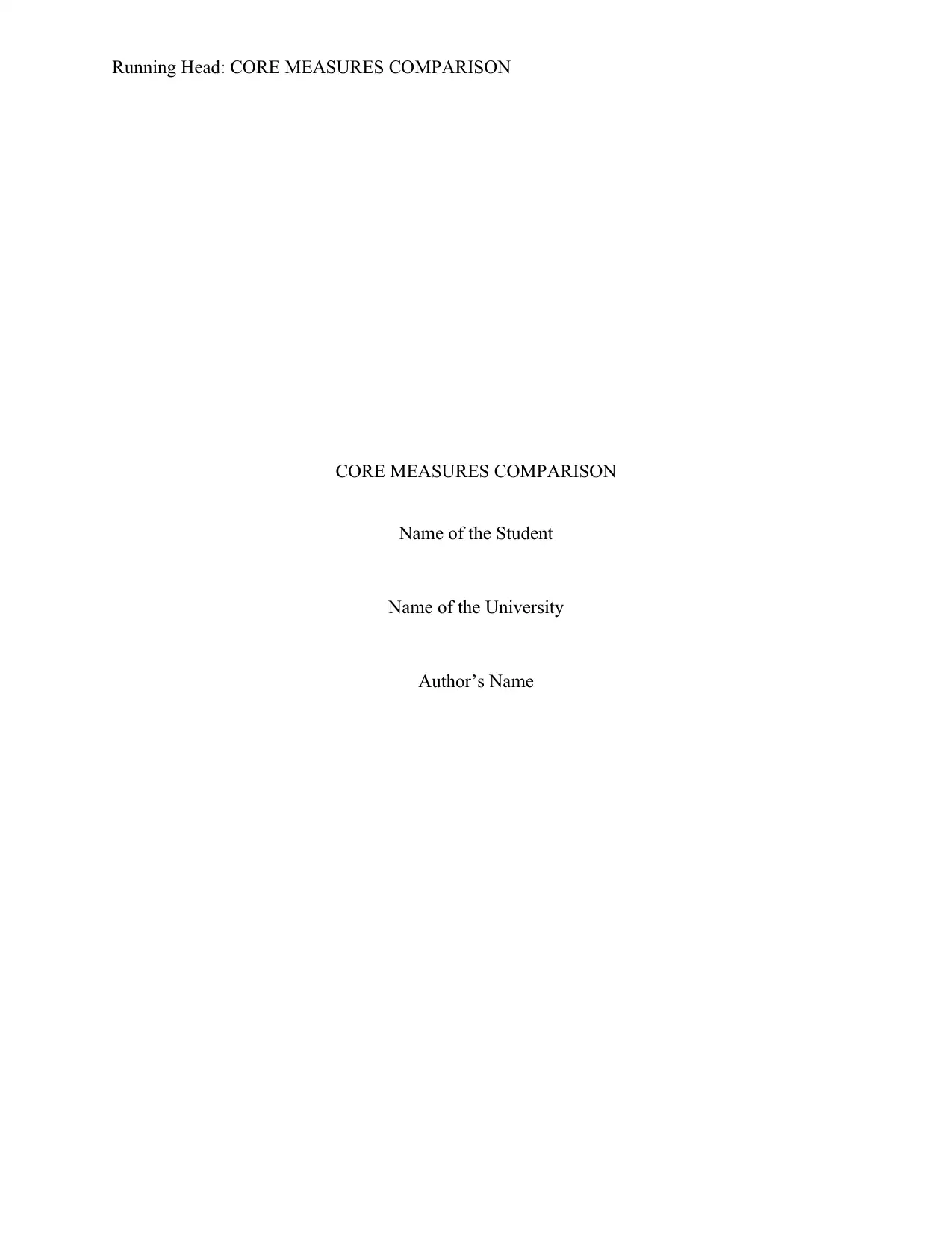
Running Head: CORE MEASURES COMPARISON
CORE MEASURES COMPARISON
Name of the Student
Name of the University
Author’s Name
CORE MEASURES COMPARISON
Name of the Student
Name of the University
Author’s Name
Paraphrase This Document
Need a fresh take? Get an instant paraphrase of this document with our AI Paraphraser
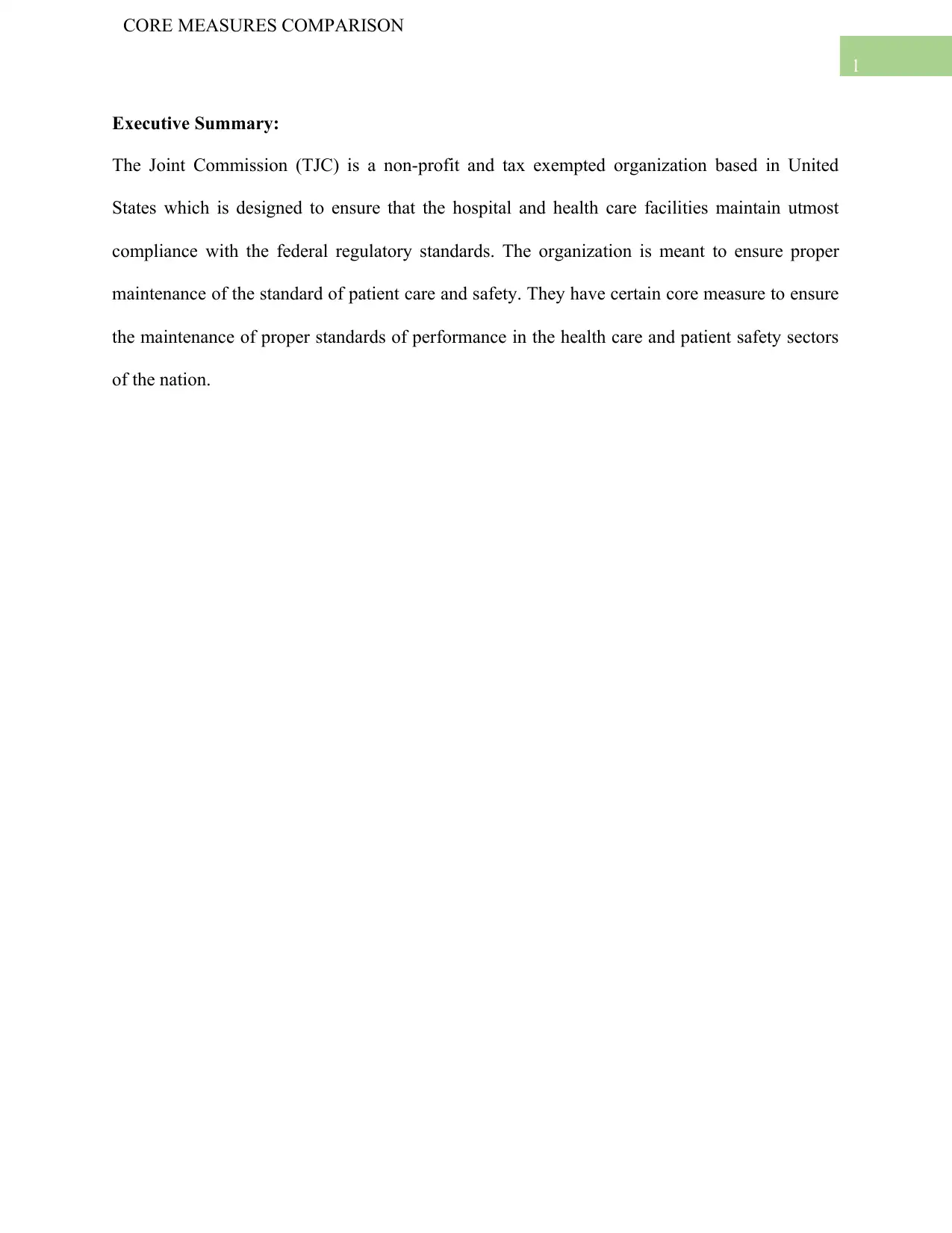
1
CORE MEASURES COMPARISON
Executive Summary:
The Joint Commission (TJC) is a non-profit and tax exempted organization based in United
States which is designed to ensure that the hospital and health care facilities maintain utmost
compliance with the federal regulatory standards. The organization is meant to ensure proper
maintenance of the standard of patient care and safety. They have certain core measure to ensure
the maintenance of proper standards of performance in the health care and patient safety sectors
of the nation.
CORE MEASURES COMPARISON
Executive Summary:
The Joint Commission (TJC) is a non-profit and tax exempted organization based in United
States which is designed to ensure that the hospital and health care facilities maintain utmost
compliance with the federal regulatory standards. The organization is meant to ensure proper
maintenance of the standard of patient care and safety. They have certain core measure to ensure
the maintenance of proper standards of performance in the health care and patient safety sectors
of the nation.
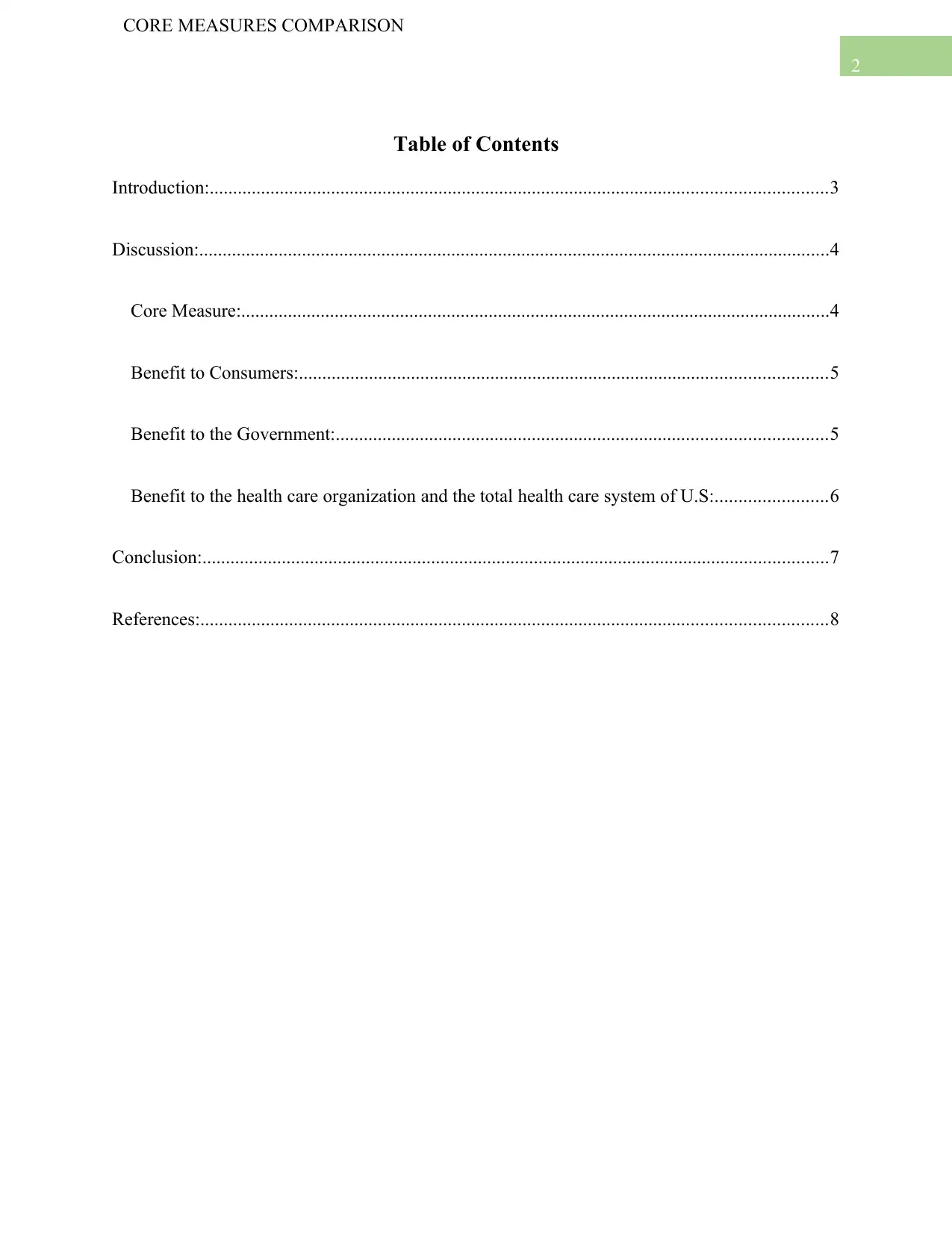
2
CORE MEASURES COMPARISON
Table of Contents
Introduction:....................................................................................................................................3
Discussion:.......................................................................................................................................4
Core Measure:..............................................................................................................................4
Benefit to Consumers:.................................................................................................................5
Benefit to the Government:.........................................................................................................5
Benefit to the health care organization and the total health care system of U.S:........................6
Conclusion:......................................................................................................................................7
References:......................................................................................................................................8
CORE MEASURES COMPARISON
Table of Contents
Introduction:....................................................................................................................................3
Discussion:.......................................................................................................................................4
Core Measure:..............................................................................................................................4
Benefit to Consumers:.................................................................................................................5
Benefit to the Government:.........................................................................................................5
Benefit to the health care organization and the total health care system of U.S:........................6
Conclusion:......................................................................................................................................7
References:......................................................................................................................................8
⊘ This is a preview!⊘
Do you want full access?
Subscribe today to unlock all pages.

Trusted by 1+ million students worldwide
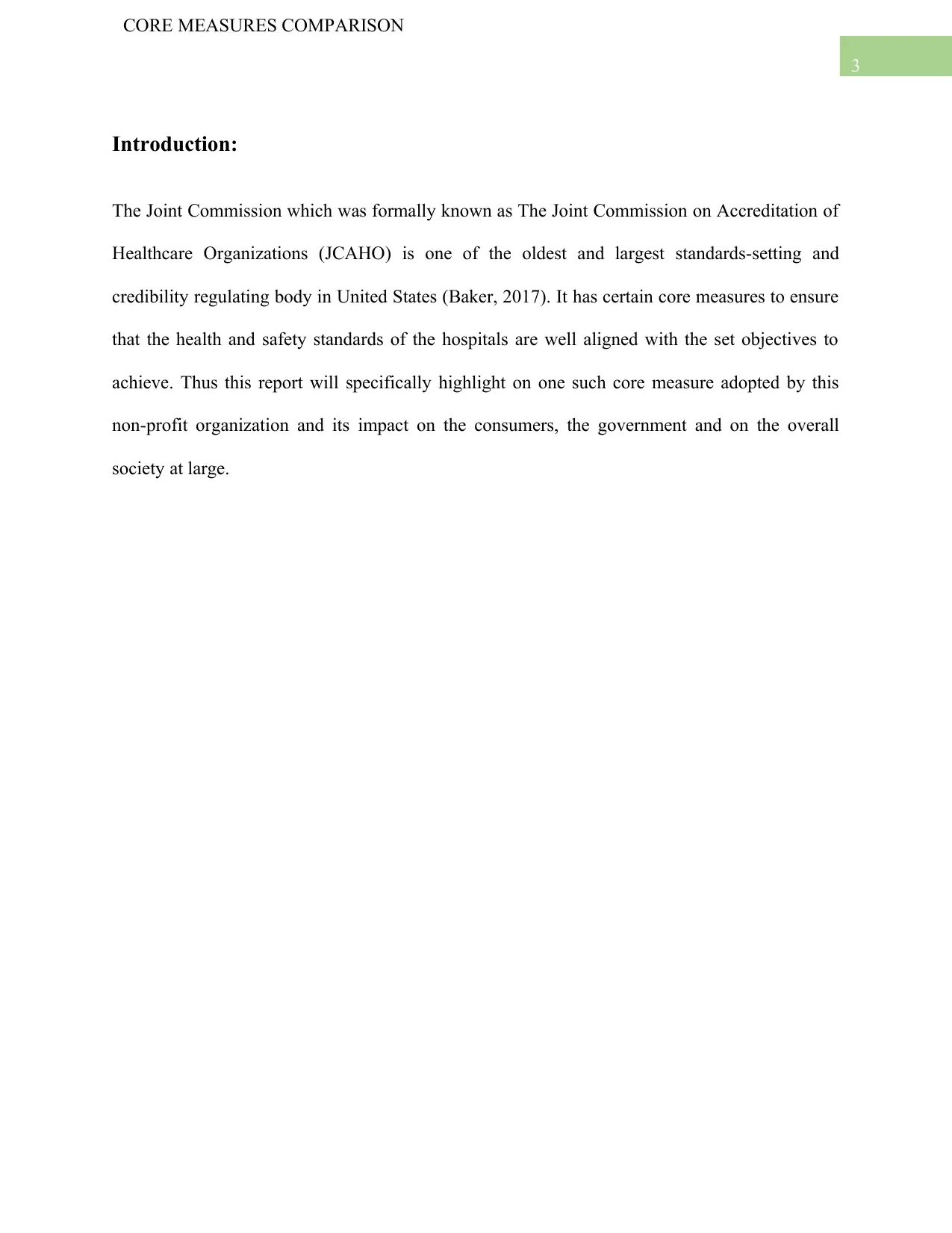
3
CORE MEASURES COMPARISON
Introduction:
The Joint Commission which was formally known as The Joint Commission on Accreditation of
Healthcare Organizations (JCAHO) is one of the oldest and largest standards-setting and
credibility regulating body in United States (Baker, 2017). It has certain core measures to ensure
that the health and safety standards of the hospitals are well aligned with the set objectives to
achieve. Thus this report will specifically highlight on one such core measure adopted by this
non-profit organization and its impact on the consumers, the government and on the overall
society at large.
CORE MEASURES COMPARISON
Introduction:
The Joint Commission which was formally known as The Joint Commission on Accreditation of
Healthcare Organizations (JCAHO) is one of the oldest and largest standards-setting and
credibility regulating body in United States (Baker, 2017). It has certain core measures to ensure
that the health and safety standards of the hospitals are well aligned with the set objectives to
achieve. Thus this report will specifically highlight on one such core measure adopted by this
non-profit organization and its impact on the consumers, the government and on the overall
society at large.
Paraphrase This Document
Need a fresh take? Get an instant paraphrase of this document with our AI Paraphraser
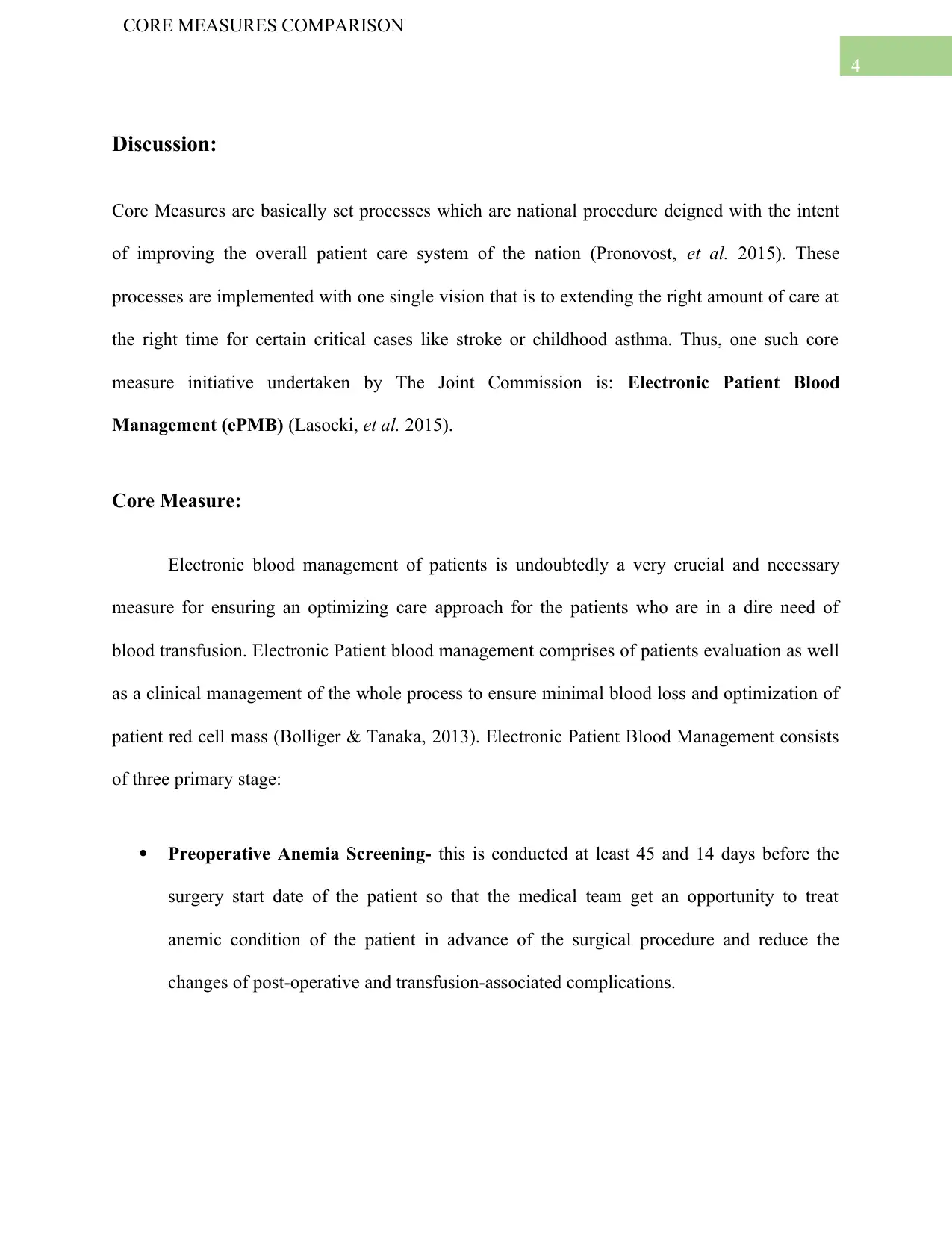
4
CORE MEASURES COMPARISON
Discussion:
Core Measures are basically set processes which are national procedure deigned with the intent
of improving the overall patient care system of the nation (Pronovost, et al. 2015). These
processes are implemented with one single vision that is to extending the right amount of care at
the right time for certain critical cases like stroke or childhood asthma. Thus, one such core
measure initiative undertaken by The Joint Commission is: Electronic Patient Blood
Management (ePMB) (Lasocki, et al. 2015).
Core Measure:
Electronic blood management of patients is undoubtedly a very crucial and necessary
measure for ensuring an optimizing care approach for the patients who are in a dire need of
blood transfusion. Electronic Patient blood management comprises of patients evaluation as well
as a clinical management of the whole process to ensure minimal blood loss and optimization of
patient red cell mass (Bolliger & Tanaka, 2013). Electronic Patient Blood Management consists
of three primary stage:
Preoperative Anemia Screening- this is conducted at least 45 and 14 days before the
surgery start date of the patient so that the medical team get an opportunity to treat
anemic condition of the patient in advance of the surgical procedure and reduce the
changes of post-operative and transfusion-associated complications.
CORE MEASURES COMPARISON
Discussion:
Core Measures are basically set processes which are national procedure deigned with the intent
of improving the overall patient care system of the nation (Pronovost, et al. 2015). These
processes are implemented with one single vision that is to extending the right amount of care at
the right time for certain critical cases like stroke or childhood asthma. Thus, one such core
measure initiative undertaken by The Joint Commission is: Electronic Patient Blood
Management (ePMB) (Lasocki, et al. 2015).
Core Measure:
Electronic blood management of patients is undoubtedly a very crucial and necessary
measure for ensuring an optimizing care approach for the patients who are in a dire need of
blood transfusion. Electronic Patient blood management comprises of patients evaluation as well
as a clinical management of the whole process to ensure minimal blood loss and optimization of
patient red cell mass (Bolliger & Tanaka, 2013). Electronic Patient Blood Management consists
of three primary stage:
Preoperative Anemia Screening- this is conducted at least 45 and 14 days before the
surgery start date of the patient so that the medical team get an opportunity to treat
anemic condition of the patient in advance of the surgical procedure and reduce the
changes of post-operative and transfusion-associated complications.
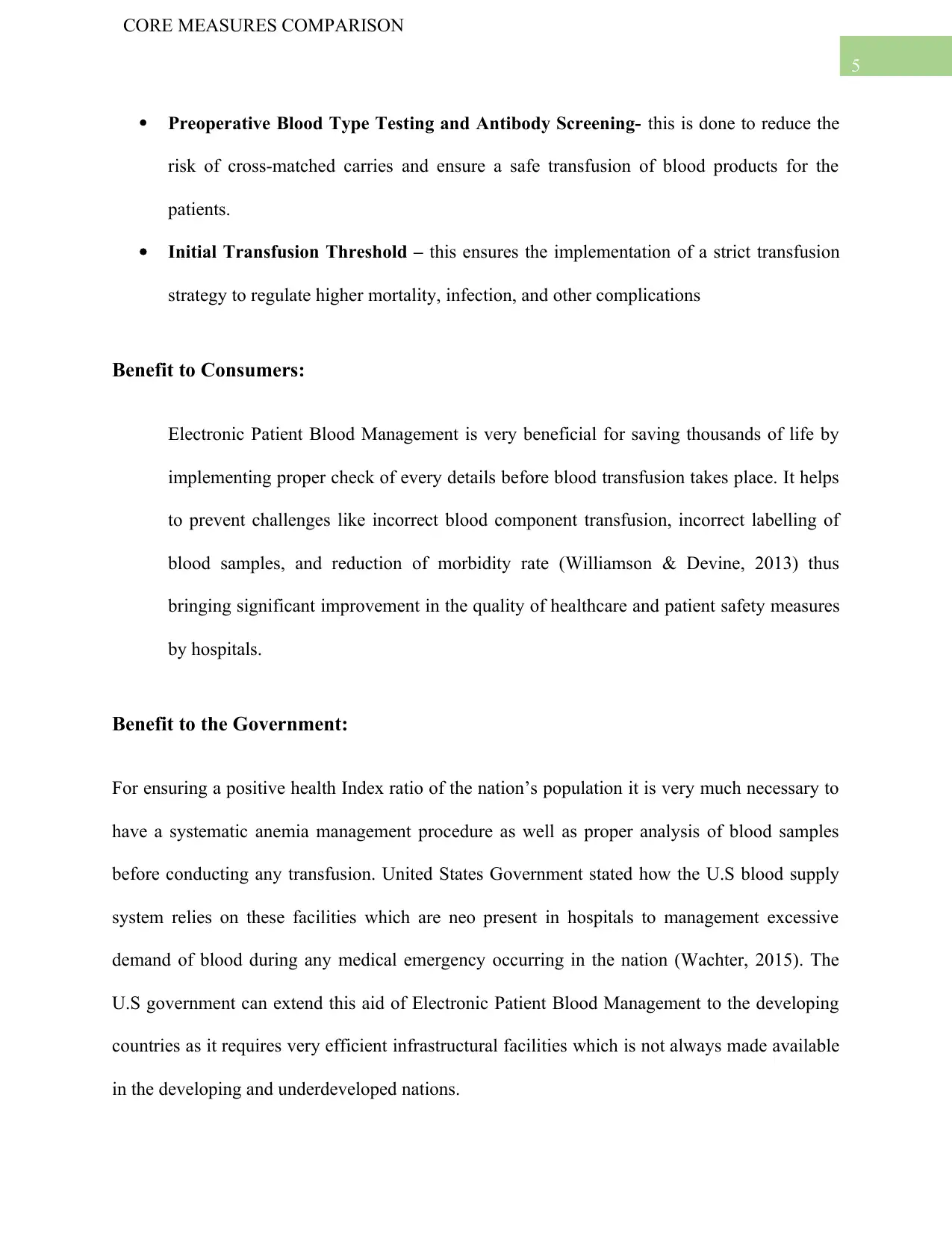
5
CORE MEASURES COMPARISON
Preoperative Blood Type Testing and Antibody Screening- this is done to reduce the
risk of cross-matched carries and ensure a safe transfusion of blood products for the
patients.
Initial Transfusion Threshold – this ensures the implementation of a strict transfusion
strategy to regulate higher mortality, infection, and other complications
Benefit to Consumers:
Electronic Patient Blood Management is very beneficial for saving thousands of life by
implementing proper check of every details before blood transfusion takes place. It helps
to prevent challenges like incorrect blood component transfusion, incorrect labelling of
blood samples, and reduction of morbidity rate (Williamson & Devine, 2013) thus
bringing significant improvement in the quality of healthcare and patient safety measures
by hospitals.
Benefit to the Government:
For ensuring a positive health Index ratio of the nation’s population it is very much necessary to
have a systematic anemia management procedure as well as proper analysis of blood samples
before conducting any transfusion. United States Government stated how the U.S blood supply
system relies on these facilities which are neo present in hospitals to management excessive
demand of blood during any medical emergency occurring in the nation (Wachter, 2015). The
U.S government can extend this aid of Electronic Patient Blood Management to the developing
countries as it requires very efficient infrastructural facilities which is not always made available
in the developing and underdeveloped nations.
CORE MEASURES COMPARISON
Preoperative Blood Type Testing and Antibody Screening- this is done to reduce the
risk of cross-matched carries and ensure a safe transfusion of blood products for the
patients.
Initial Transfusion Threshold – this ensures the implementation of a strict transfusion
strategy to regulate higher mortality, infection, and other complications
Benefit to Consumers:
Electronic Patient Blood Management is very beneficial for saving thousands of life by
implementing proper check of every details before blood transfusion takes place. It helps
to prevent challenges like incorrect blood component transfusion, incorrect labelling of
blood samples, and reduction of morbidity rate (Williamson & Devine, 2013) thus
bringing significant improvement in the quality of healthcare and patient safety measures
by hospitals.
Benefit to the Government:
For ensuring a positive health Index ratio of the nation’s population it is very much necessary to
have a systematic anemia management procedure as well as proper analysis of blood samples
before conducting any transfusion. United States Government stated how the U.S blood supply
system relies on these facilities which are neo present in hospitals to management excessive
demand of blood during any medical emergency occurring in the nation (Wachter, 2015). The
U.S government can extend this aid of Electronic Patient Blood Management to the developing
countries as it requires very efficient infrastructural facilities which is not always made available
in the developing and underdeveloped nations.
⊘ This is a preview!⊘
Do you want full access?
Subscribe today to unlock all pages.

Trusted by 1+ million students worldwide
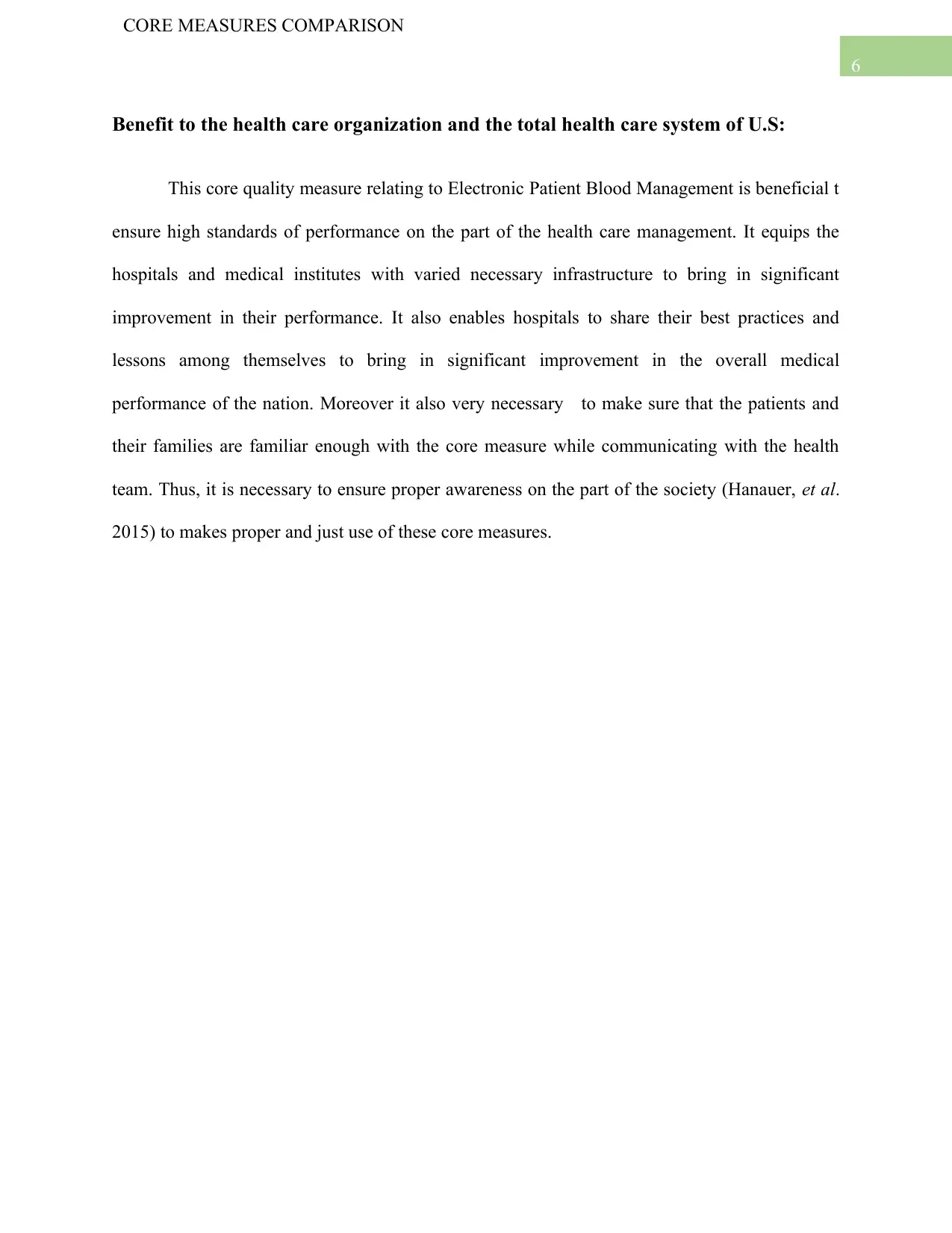
6
CORE MEASURES COMPARISON
Benefit to the health care organization and the total health care system of U.S:
This core quality measure relating to Electronic Patient Blood Management is beneficial t
ensure high standards of performance on the part of the health care management. It equips the
hospitals and medical institutes with varied necessary infrastructure to bring in significant
improvement in their performance. It also enables hospitals to share their best practices and
lessons among themselves to bring in significant improvement in the overall medical
performance of the nation. Moreover it also very necessary to make sure that the patients and
their families are familiar enough with the core measure while communicating with the health
team. Thus, it is necessary to ensure proper awareness on the part of the society (Hanauer, et al.
2015) to makes proper and just use of these core measures.
CORE MEASURES COMPARISON
Benefit to the health care organization and the total health care system of U.S:
This core quality measure relating to Electronic Patient Blood Management is beneficial t
ensure high standards of performance on the part of the health care management. It equips the
hospitals and medical institutes with varied necessary infrastructure to bring in significant
improvement in their performance. It also enables hospitals to share their best practices and
lessons among themselves to bring in significant improvement in the overall medical
performance of the nation. Moreover it also very necessary to make sure that the patients and
their families are familiar enough with the core measure while communicating with the health
team. Thus, it is necessary to ensure proper awareness on the part of the society (Hanauer, et al.
2015) to makes proper and just use of these core measures.
Paraphrase This Document
Need a fresh take? Get an instant paraphrase of this document with our AI Paraphraser
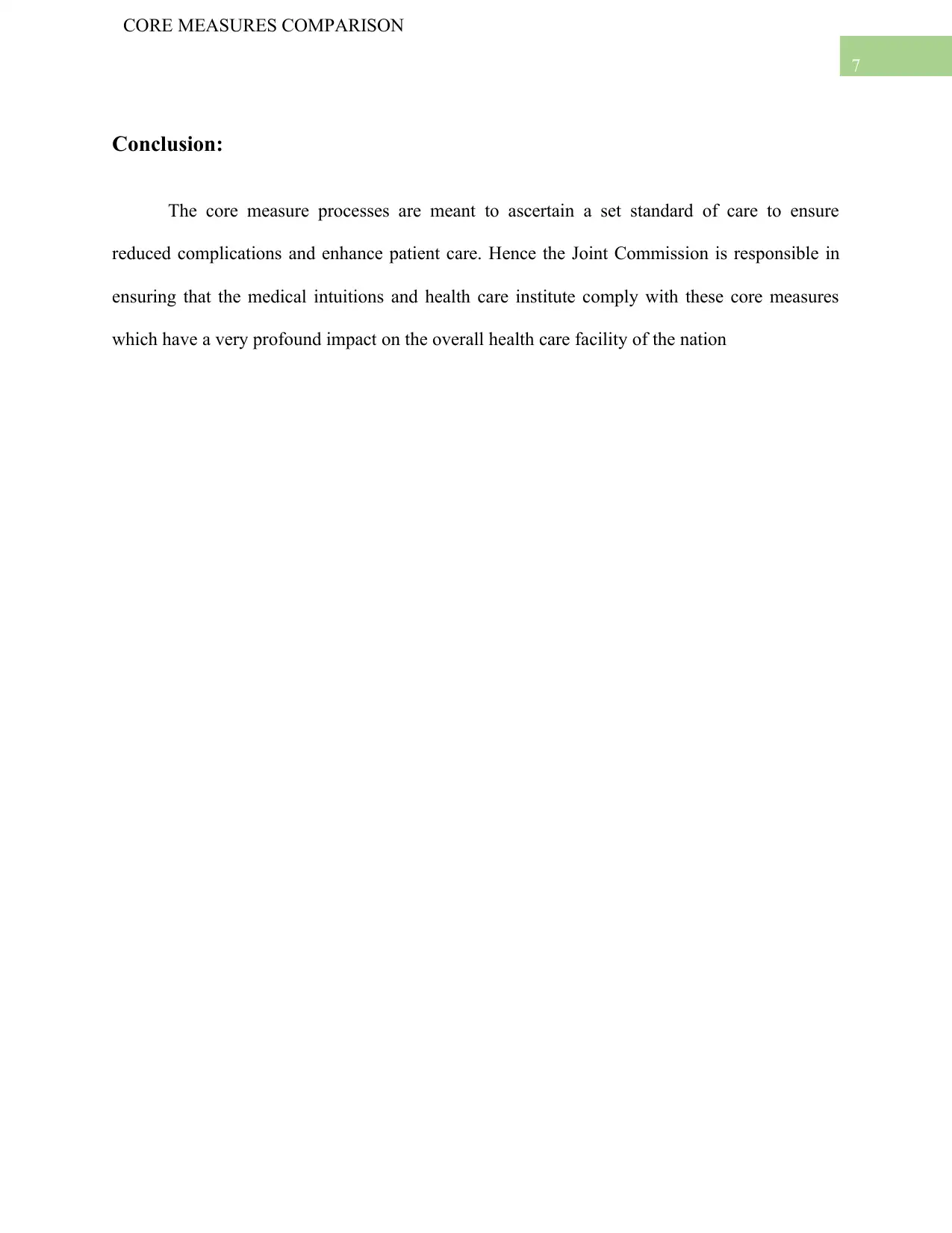
7
CORE MEASURES COMPARISON
Conclusion:
The core measure processes are meant to ascertain a set standard of care to ensure
reduced complications and enhance patient care. Hence the Joint Commission is responsible in
ensuring that the medical intuitions and health care institute comply with these core measures
which have a very profound impact on the overall health care facility of the nation
CORE MEASURES COMPARISON
Conclusion:
The core measure processes are meant to ascertain a set standard of care to ensure
reduced complications and enhance patient care. Hence the Joint Commission is responsible in
ensuring that the medical intuitions and health care institute comply with these core measures
which have a very profound impact on the overall health care facility of the nation
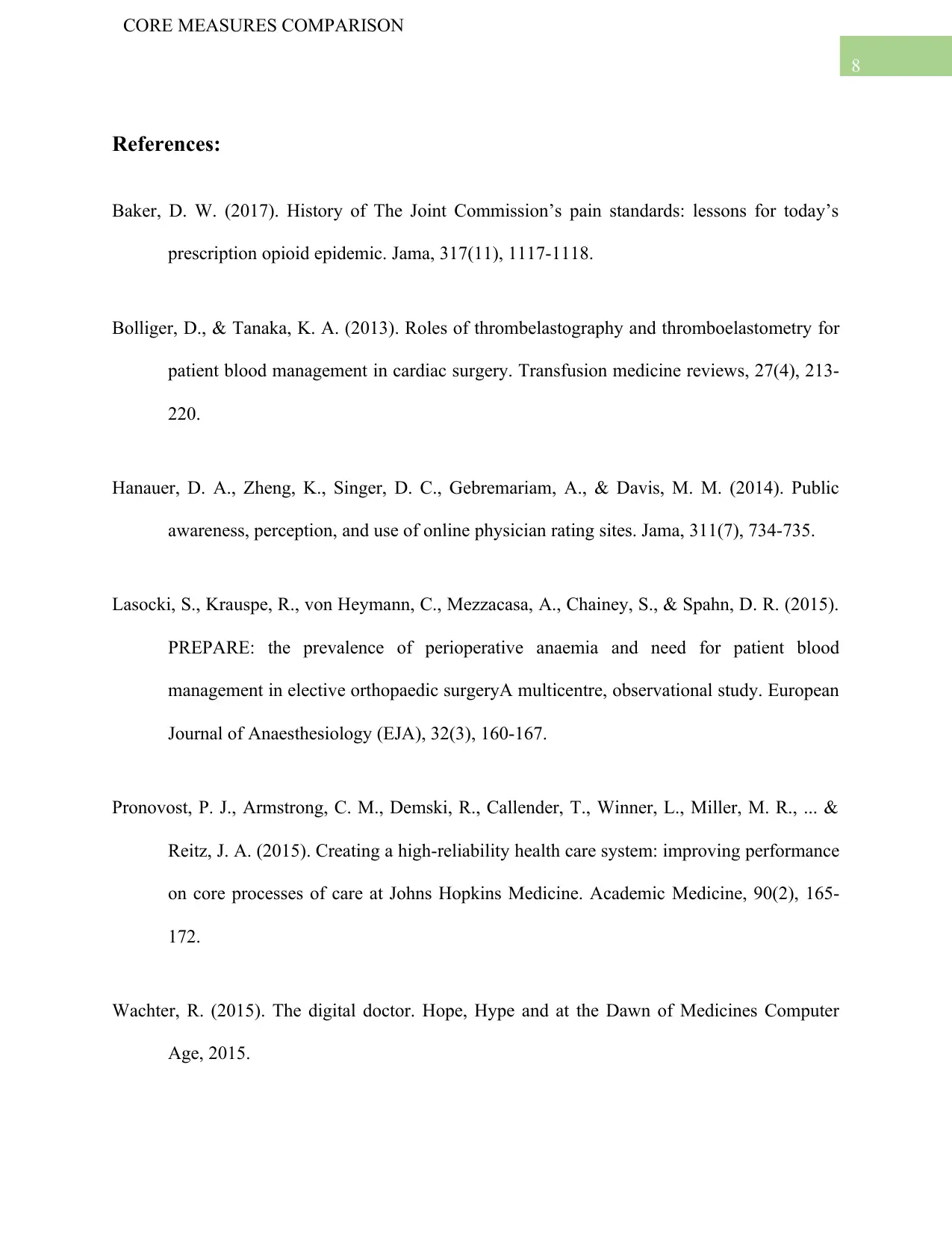
8
CORE MEASURES COMPARISON
References:
Baker, D. W. (2017). History of The Joint Commission’s pain standards: lessons for today’s
prescription opioid epidemic. Jama, 317(11), 1117-1118.
Bolliger, D., & Tanaka, K. A. (2013). Roles of thrombelastography and thromboelastometry for
patient blood management in cardiac surgery. Transfusion medicine reviews, 27(4), 213-
220.
Hanauer, D. A., Zheng, K., Singer, D. C., Gebremariam, A., & Davis, M. M. (2014). Public
awareness, perception, and use of online physician rating sites. Jama, 311(7), 734-735.
Lasocki, S., Krauspe, R., von Heymann, C., Mezzacasa, A., Chainey, S., & Spahn, D. R. (2015).
PREPARE: the prevalence of perioperative anaemia and need for patient blood
management in elective orthopaedic surgeryA multicentre, observational study. European
Journal of Anaesthesiology (EJA), 32(3), 160-167.
Pronovost, P. J., Armstrong, C. M., Demski, R., Callender, T., Winner, L., Miller, M. R., ... &
Reitz, J. A. (2015). Creating a high-reliability health care system: improving performance
on core processes of care at Johns Hopkins Medicine. Academic Medicine, 90(2), 165-
172.
Wachter, R. (2015). The digital doctor. Hope, Hype and at the Dawn of Medicines Computer
Age, 2015.
CORE MEASURES COMPARISON
References:
Baker, D. W. (2017). History of The Joint Commission’s pain standards: lessons for today’s
prescription opioid epidemic. Jama, 317(11), 1117-1118.
Bolliger, D., & Tanaka, K. A. (2013). Roles of thrombelastography and thromboelastometry for
patient blood management in cardiac surgery. Transfusion medicine reviews, 27(4), 213-
220.
Hanauer, D. A., Zheng, K., Singer, D. C., Gebremariam, A., & Davis, M. M. (2014). Public
awareness, perception, and use of online physician rating sites. Jama, 311(7), 734-735.
Lasocki, S., Krauspe, R., von Heymann, C., Mezzacasa, A., Chainey, S., & Spahn, D. R. (2015).
PREPARE: the prevalence of perioperative anaemia and need for patient blood
management in elective orthopaedic surgeryA multicentre, observational study. European
Journal of Anaesthesiology (EJA), 32(3), 160-167.
Pronovost, P. J., Armstrong, C. M., Demski, R., Callender, T., Winner, L., Miller, M. R., ... &
Reitz, J. A. (2015). Creating a high-reliability health care system: improving performance
on core processes of care at Johns Hopkins Medicine. Academic Medicine, 90(2), 165-
172.
Wachter, R. (2015). The digital doctor. Hope, Hype and at the Dawn of Medicines Computer
Age, 2015.
⊘ This is a preview!⊘
Do you want full access?
Subscribe today to unlock all pages.

Trusted by 1+ million students worldwide

9
CORE MEASURES COMPARISON
Williamson, L. M., & Devine, D. V. (2013). Challenges in the management of the blood supply.
the Lancet, 381(9880), 1866-1875.
CORE MEASURES COMPARISON
Williamson, L. M., & Devine, D. V. (2013). Challenges in the management of the blood supply.
the Lancet, 381(9880), 1866-1875.
1 out of 10
Related Documents
Your All-in-One AI-Powered Toolkit for Academic Success.
+13062052269
info@desklib.com
Available 24*7 on WhatsApp / Email
![[object Object]](/_next/static/media/star-bottom.7253800d.svg)
Unlock your academic potential
Copyright © 2020–2025 A2Z Services. All Rights Reserved. Developed and managed by ZUCOL.





